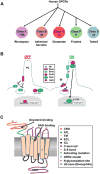Smoothened Regulation: A Tale of Two Signals
- PMID: 26432668
- PMCID: PMC4593303
- DOI: 10.1016/j.tips.2015.09.001
Smoothened Regulation: A Tale of Two Signals
Abstract
The G protein-coupled receptor (GPCR) Smoothened (Smo) is the signal transducer of the developmentally and therapeutically relevant Hedgehog (Hh) pathway. Although recent structural analyses have advanced our understanding of Smo biology, several questions remain. Chief among them are the identity of its natural ligand, the regulatory processes controlling its activation, and the mechanisms by which it signals to downstream effectors. In this review, we discuss recent discoveries from multiple model systems that have set the stage for solving these mysteries. We focus on the roles of distinct Smo functional domains, post-translational modifications, and trafficking, and conclude by discussing their contributions to signal output.
Keywords: GPCR; Hedgehog; Smoothened; canonical signaling; noncanonical signaling.
Copyright © 2015 Elsevier Ltd. All rights reserved.
Figures



References
-
- Ingham PW, McMahon AP. Hedgehog signaling in animal development: paradigms and principles. Genes Dev. 2001;15(23):3059–87. - PubMed
-
- Robbins DJ, Goetz JA, Yuan Z, Stegman MA. Inhibitors of the Hedgehog Signal Transduction Pathway. Curr Cancer Ther Rev. 2005;1:227–288.
-
- Stone DM, Hynes M, Armanini M, Swanson TA, Gu Q, Johnson RL, Scott MP, Pennica D, Goddard A, Phillips H, Noll M, Hooper JE, de Sauvage F, Rosenthal A. The tumour-suppressor gene patched encodes a candidate receptor for Sonic hedgehog. Nature. 1996;384(6605):129–34. - PubMed
Publication types
MeSH terms
Substances
Grants and funding
LinkOut - more resources
Full Text Sources
Other Literature Sources
Molecular Biology Databases
Miscellaneous

